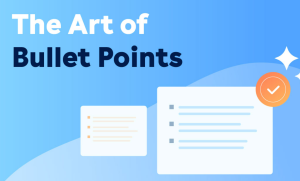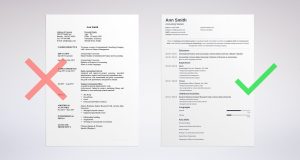Resume writing is a lot like creating a self-sculpture. The artist molds the clay or carves the stone into a picture of himself for the world to see. There are many unseen pitfalls in the process. By overdoing it, the artist could deviate from the truth and could end up with a caricature of himself. On the other hand, holding back could lead to something that may not end up in the history books.
Formatting a resume is about highlighting the merits and desirable characteristics to the potential employers for a specific position. A resume is made up of different sections, each one serving a specific purpose. Apart from the usual words of wisdom, aspirants need to be aware of the dos and don’ts of the process which we will cover in this blog.
Resume That Works is a premier resume writing service that offers exceptional services to its clients across the globe. Whether you are an accounting professional or a doctor, we can always provide you with the best resume that can lead to a high-paying job. So, get your custom resume today!
Formatting A Professional Resume
There is a clear difference between formatting a resume and then doing it professionally. The former is merely about getting all the important sections and elements into the mix and hoping that they would work somehow. For the latter, it is about adding value to the document in such a way that the finished product becomes much more than the sum of its parts.
A professional resume lets the aspirants become prominent in the sea of candidates. The writer of the resume understands the demand of the hour and then delivers on the premise by structuring and formatting the contents exceptionally.
Nowadays, every position comes with tremendous competition. That’s why aspirants must have their best foot forward. It will not only help them in getting promoted to the interview stage but will help them in impressing employers further down the road.
Dos of Resume Formatting
Resume formatting is more about how the content in the document is structured, rather than its mere existence. It revolves around the look and feel of the resume, from its physical aspects to the ultimate perception of the document. In this section, we will cover some of the best practices in formatting a solid resume in the form of dos. So, let us dive deeper into them without further ado.
Using Legible & Clear Font
The first order of business in making a resume prominent is making it easier for the recruiters and any other intended readers to go through the contents. Aspirants should keep in mind that hiring managers do not have more than a couple of seconds to screen a resume. So, facilitating them by making the text reader-friendly is a win-win.
Employing Bullets To Convey The Message
The overall structure of a resume supports conciseness and succinctness over description. That’s why sections with the bulk information are covered through bullet points. They allow the writers to be more direct and assertive in sharing information, whether it is work experience examples or detail about educational qualifications. Applicants need to be able to say more in less through strategic bullet points.
Taking Advantage of The Margins
Margins for resumes hold a special place in the overall structure. As a standard practice, aspirants should leave a one-inch margin on both the horizontal and vertical sides of the document. However, they can employ the blank space by cramming information seamlessly. For instance, they can add skills, hobbies, and interests that can help recruiters prefer them over others.
Optimize The Resume According To The JD
Every vacancy comes with some sort of official job description. A JD highlights what the employer expects from their potential employees in terms of responsibilities, eligibility, and more. If you ask what is a formatted resume, he would tell you that the best one would the one that is optimized against its intended position. Additionally, candidates can get through ATS by incorporating keywords and phrases in the resume from JD.
Using Consistent Formatting
When it comes to the best practices in resume writing and designing, developing and using consistent formatting is one of the most important ones. It includes choosing the right font size, font style, and the width of margins on both sides. Aspirants should always be aware of the different aspects of fonts because they should be the same across the document.
Don’ts of Resume Formatting
Picking An Obscure Font
One of the problems common in many resumes is the illegibility of the font of the text. Many aspirants in their bid to stand out choose fancy fonts. This results in an overall poor understanding of what is written in the document. Recruiters do not think twice before discarding a resume based on forced readability.
Writing Large Blocks of Description
After using an illegible font, the biggest letdown in a resume could be using large blocks of description and text. If you are wondering how to organize your resume, you need to resort to short but forceful bullets over chunks of content. No one has the time and energy to comb through paragraphs, especially the recruiters and hiring managers, to know about the work experience or education of a candidate. On the contrary, the more readily a piece of information is available, the better.
Abusing Italics & Boldness
Using italicized or bold fonts is one of the simplest ways to make something more prominent and pop to the eye of the beholder. This is truer than ever in the case of resume formatting. But many aspirants overuse the thing to a point where the whole document gets filled with slightly tilted and prominent words. If only redundancy had a face, it would look a lot like that resume!
Inconsistency In The Format For Resume
Where the best practices get the consistent format, the don’ts of the game get its opposite. There is no denying that moving to and fro between the formatting styles and spaces can become a nuisance. At the very least, it is distracting and showcases how little attention to the details that particular aspirant pays. So, it is a big NO with using Calibri font in the beginning and then switching to Arial at the end.
Adding Irrelevant Information
Resumes are designed to be short and bold if anything at all. Their formatting and structure do not allow irrelevancy in both sections and contents. When you are applying for a job, make sure to have only relevant information for that position. For instance, if you are applying for a digital marketing position, you should only mention your experience in the field. There is no need to tell the recruiters about your day’s lifeguarding at the local pool.
Bonus Tips On How To Organize Your Resume
After going through the dos and don’ts of the game, it is time to share some tips on how to stuff more value to the document. Keep in mind that resume writing and formatting is not everyone’s game, yet many do not have spare cash lying around to get premium resume writing services. That’s where Resume That Works enters the picture! With some of the best resume writers in the game and years of experience, we offer competitive pricing on all our offerings.
For now, let’s spill the beans on some of the best tips to organize your resume.
Using A Professional Email Address
The least an aspirant can do is to spare the recruiters of casual email addresses. If anything, it shows them that the applicant does not have class. That’s why they should use professional email address all the time.
Keeping It Succinct & Vigorous
We cannot stress this fact enough but let’s try to do it one more time. A resume, by default, is a bold and forceful document. It cannot do more with bullets and one-liners than paragraphs and passages about job experience and skills. So, keeping it short is always a better approach.
Optimizing The Resume For Application Tracking Systems (ATS)
At this point, almost every industry utilizes ATS for the initial screening. It means that the software is trained to screen out resumes that do not contain the relevant keywords in all the major sections. To avoid the fall, aspirants should optimize their resumes accordingly.
Reviewing The Resume Before Submission
Writing a resume is one thing, but writing it in a way that clicks with the recruiters is something else. To achieve that, aspirants need to go through the drafts several times before they can get to the best version of the document. That’s why reviewing and proofreading the resume should be the SOP for all aspirants.
Final Thoughts
Even in the presence of line platforms and media, resumes are still the best mode of communicating with recruiters and hiring managers. A majority of candidates make their resumes their calling cards, with impeccable content and solid structure. In this blog, we have shed ample light on the structure and formatting of resumes. Our aim has always been to enable professionals to get one step closer to their dream jobs!







